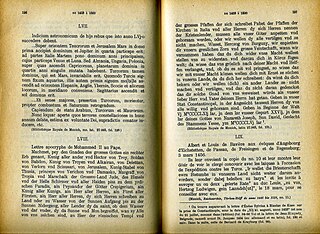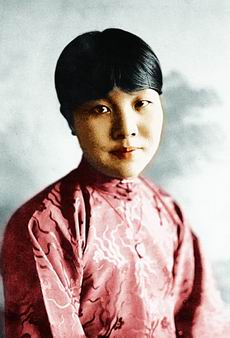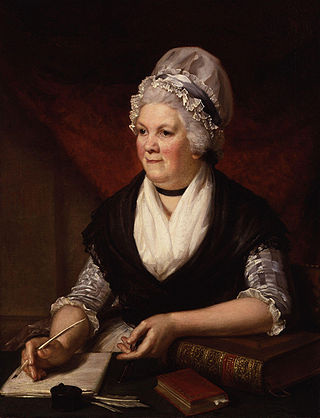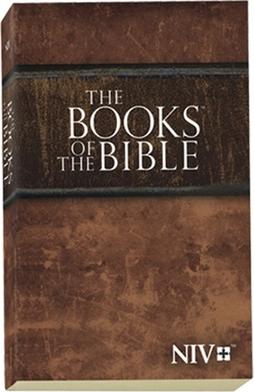
Apocrypha are biblical or related writings not forming part of the accepted canon of scripture, some of which might be of doubtful authorship or authenticity. In Christianity, the word apocryphal (ἀπόκρυφος) was first applied to writings that were to be read privately rather than in the public context of church services. Apocrypha were edifying Christian works that were not always initially included as canonical scripture.

Pearl Comfort Sydenstricker Buck was an American writer and novelist. She is best known for The Good Earth, the best-selling novel in the United States in 1931 and 1932 and which won her the Pulitzer Prize in 1932. In 1938, Buck became the first American woman to win the Nobel Prize in Literature "for her rich and truly epic descriptions of peasant life in China" and for her "masterpieces", two memoir-biographies of her missionary parents.

Katherine Womeldorf Paterson is an American writer best known for children's novels, including Bridge to Terabithia. For four different books published 1975–1980, she won two Newbery Medals and two National Book Awards. She is one of four people to win the two major international awards; for "lasting contribution to children's literature" she won the biennial Hans Christian Andersen Award for Writing in 1998 and for her career contribution to "children's and young adult literature in the broadest sense" she won the Astrid Lindgren Memorial Award from the Swedish Arts Council in 2006, the biggest monetary prize in children's literature. Also for her body of work she was awarded the NSK Neustadt Prize for Children's Literature in 2007 and the Laura Ingalls Wilder Medal from the American Library Association in 2013. She was the second US National Ambassador for Young People's Literature, serving 2010 and 2011.

The Good Earth is a historical fiction novel by Pearl S. Buck published in 1931 that dramatizes family life in an early 20th-century Chinese village in Anhwei. It is the first book in her House of Earth trilogy, continued in Sons (1932) and A House Divided (1935). It was the best-selling novel in the United States in both 1931 and 1932, won the Pulitzer Prize for Fiction in 1932, and was influential in Buck's winning the Nobel Prize for Literature in 1938. Buck, who grew up in China as the daughter of American missionaries, wrote the book while living in China and drew on her first-hand observation of Chinese village life. The realistic and sympathetic depiction of the farmer Wang Lung and his wife O-Lan helped prepare Americans of the 1930s to consider Chinese as allies in the coming war with Japan.

Chapter and verse divisions did not appear in the original texts of Jewish or Christian bibles; such divisions form part of the paratext of the Bible. Since the early 13th century, most copies and editions of the Bible have presented all but the shortest of the scriptural books with divisions into chapters, generally a page or so in length. Since the mid-16th century, editors have further subdivided each chapter into verses – each consisting of a few short lines or of one or more sentences. In the King James Version (KJV) Esther 8:9 is the longest verse and John 11:35 is the shortest. Sometimes a sentence spans more than one verse, as in the case of Ephesians 2:8–9, and sometimes there is more than one sentence in a single verse, as in the case of Genesis 1:2.

Xie Wanying, better known by her pen name Bing Xin or Xie Bingxin, was one of the most prolific Chinese women writers of the 20th century. Many of her works were written for young readers. She was the chairperson of the China Federation of Literary and Art Circles. Her pen name Bing Xin carries the meaning of a morally pure heart, and is taken from a line in a Tang dynasty poem by Wang Changling.

Sarah Trimmer was an English writer and critic of 18th-century British children's literature, as well as an educational reformer. Her periodical, The Guardian of Education, helped to define the emerging genre by seriously reviewing children's literature for the first time; it also provided the first history of children's literature, establishing a canon of the early landmarks of the genre that scholars still use today. Trimmer's most popular children's book, Fabulous Histories, inspired numerous children's animal stories and remained in print for over a century.
Susan Hilary Spurling CBE FRSL is a British writer, known for her work as a journalist and biographer.
Catherine Bateson is an Australian writer.

Moffatt, New Translation (MNT) is an abbreviation of the title The Holy Bible Containing the Old and New Testaments, a New Translation by James Moffatt.

The Manga Bible: From Genesis to Revelation is an original English-language manga adaptation of the Bible created by British artist Ajinbayo "Siku" Akinsiku, who was responsible for the concept and the art and the scripter Akin Akinsiku. It was released in July 2007 by Galilee Trade. They summarize the narrative of the Bible in a 200-page graphic novel including the Old Testament and the New Testament. With their work, they combine the Western and the Japanese culture to tell the Bible in a new way. The book is especially aimed at readers between the ages of 15 and 25. Church representatives were praising the graphic novel, as opening up the ideas of the Bible to a new target group. Ajinbayo Akinsiku was born in England and grew up in Nigeria; he now lives again in England. He thus represents different cultures in his artistic work, which becomes also apparent in The Manga Bible. He became known for his work on 2000 AD and Judge Dredd.

The Pearl S. Buck Birthplace is a historic home in Hillsboro, West Virginia where American writer Pearl S. Buck was born. The home now serves as a museum offering guided tours. The site also includes a carpentry shop and barn with over 100 historic farm and woodworking tools, and the log home of Buck's father's family, the Sydenstrickers, which was moved from Greenbrier County.

Absalom Andrew Sydenstricker was an American Presbyterian missionary to China from 1880 to 1931. The Sydenstricker log house at what later became the Pearl S. Buck Birthplace in Hillsboro, West Virginia, was Absalom's early childhood home. He was of German descent.

The Books of the Bible is the first presentation of an unabridged committee translation of the Bible to remove chapter and verse numbers entirely and instead present the biblical books according to their natural literary structures. This edition of the Bible is also noteworthy for the way it recombines books that have traditionally been divided, and for the way it puts the biblical books in a different order.

The Exile is a memoir/biography, or work of creative non-fiction, written by Pearl S. Buck about her mother, Caroline Stulting Sydenstricker (1857–1921), describing her life growing up in West Virginia and life in China as the wife of the Presbyterian missionary Absalom Sydenstricker. The book is deeply critical of her father and the mission work in China for their treatment of women. Buck also traces the arc of her mother's disillusionment with religion. The success of the book led Buck to write a parallel memoir of her father, Fighting Angel, New York: John Day, 1936.

Fighting Angel: Portrait of a Soul (1936) is a memoir, sometimes called a "creative non-fiction novel," written by Pearl S. Buck about her father, Absalom Sydenstricker (1852–1931) as a companion to her memoir of her mother, The Exile.
John Lossing Buck was an American agricultural economist specializing in the rural economy of China. He first went to China in 1915 as an agricultural missionary for the American Presbyterian Mission and was based in China until 1944. His wife, whom he later divorced, was Nobel Prize-winning author Pearl S. Buck.
Kala Keerthi Sybil Wettasinghe was a children's book writer and an illustrator in Sri Lanka. Considered as the doyen of children's literature in Sri Lanka, Wettasinghe has produced more than 200 children's books which have been translated into several languages. Two of her best known works are "Child In Me" and "Eternally Yours".

Let My People Go: Bible Stories Told by a Freeman of Color is a 1998 book by Patricia McKissack. Set in 19th century South Carolina, it is about a freed slave, Price Jeffries, who uses Bible stories from the Old Testament to answer questions that his daughter, Charlotte, poses about the things she sees around her.

The 1938 Nobel Prize in Literature was awarded to the American author Pearl S. Buck (1892–1973) "for her rich and truly epic descriptions of peasant life in China and for her biographical masterpieces." Buck was the first female American to be awarded the Nobel Prize and the third American recipient following Eugene O'Neill in 1936 and Sinclair Lewis in 1930. She was also the fourth woman to receive the prize.















